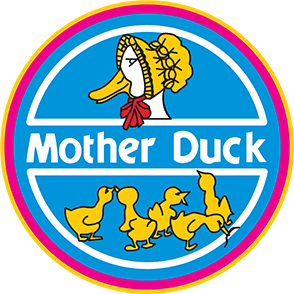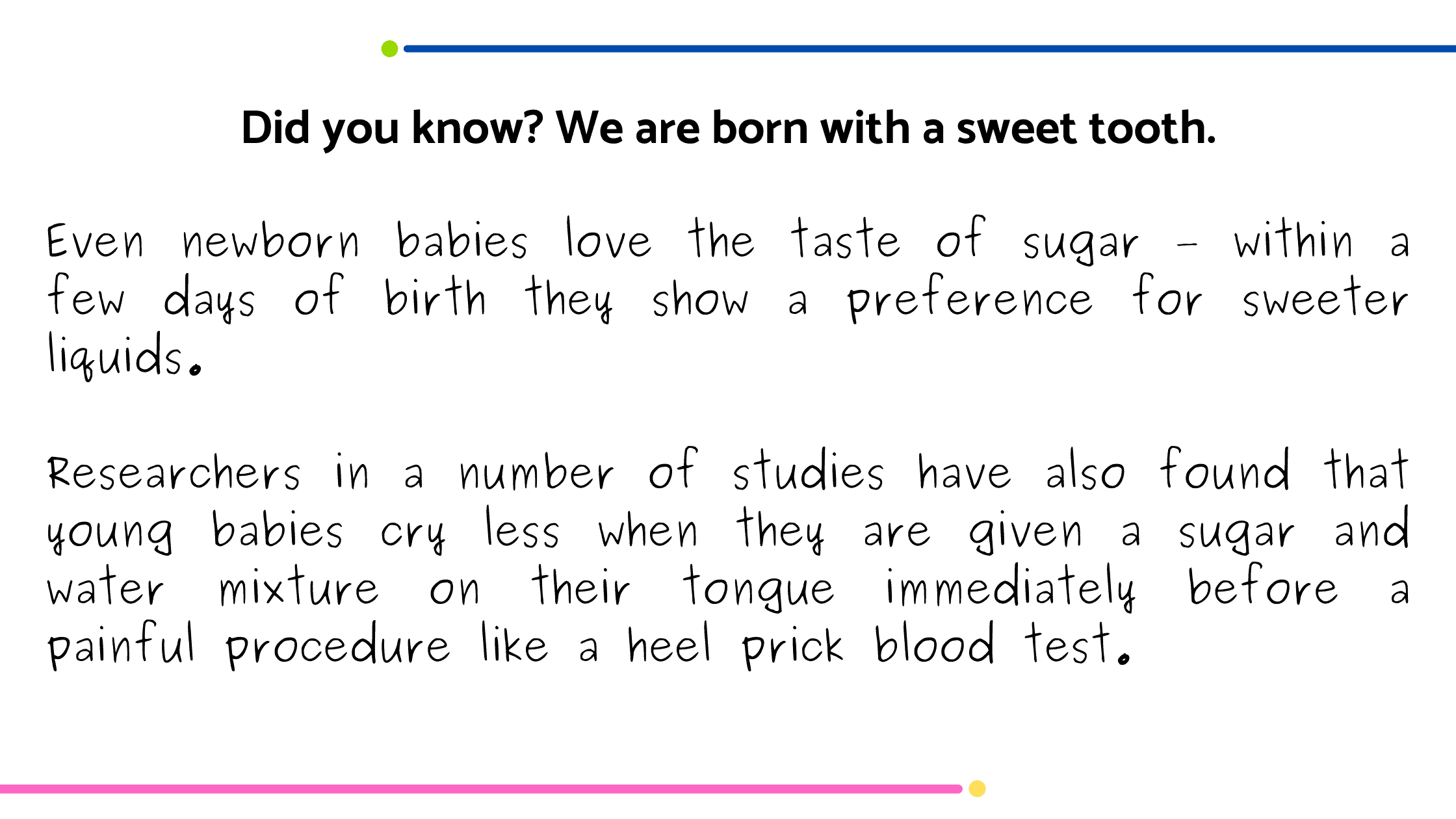
Are Our Kids Eating Too Much Sugar?
Sugar – this deliciously sweet substance has such a sour reputation. It’s a taste our children adore, yet also something we feel the need to protect them from. In this blog, I’ll explore why our feelings about sugar are so mixed and where to draw the line in how much our children eat.
Why do we enjoy sugar so much?
Sweetness is one of the primary flavours our taste buds are designed to recognise. In fact, scientists have shown that babies enjoy sweet flavour from birth – it’s programmed into us. Perhaps this helps to prime the taste buds for breast milk, which is significantly sweeter than cows’ milk.
There are other theories for why we turn towards sweet foods. Possibly, our bodies instinctively know they are a concentrated source of the kilojoules we require to keep us functioning. And we may have been conditioned to think that these are the foods that bring us comfort when we are in pain, whether it’s the childhood physical pain of a bumped knee or the grownup emotional pain of a broken heart…I think this is getting beyond the realm of the dietitian and into the psychology department though!
Whatever the reason, there’s no doubt that too much sugar is a bad thing at any age.
Why is too much sugar a problem?
The first issue most people think about with sugar is increased weight. And yes, in an age of so many adults and even young children being overweight, this is a great concern.
There’s also the fact most kids reach for sweet and less healthy foods first. They may fill up on them, and lose their appetite for the more nutritious foods their growing bodies need.
Another worry is the health of our children’s teeth. Sugary foods are known to promote tooth decay. You can read more about this in next month’s article.
Are we eating too much?
Yes, many of us are eating too much sugar. The World Health Organisation (WHO) recommended in 2015 that children and adults alike should eat no more than 10% of their kilojoules as ‘free sugars’ (read on to see what they mean by this term). However, the latest information on what Aussies are eating tells us that our average intake is 10.9% of kilojoules as sugar. While that sounds only a little above the mark, about half of 2-3-year-olds are exceeding the guideline.
The news just gets worse from there for our kids, with sugar intake rising through childhood to the point that almost three-quarters of 9-18-year-olds are eating too much. And this is at an age when children grow rapidly and badly need foods supplying an abundance of protein, vitamins, and minerals, not empty kilojoules.
What is 10% of kilojoules in the ‘real world’?
This is quite a tricky concept – it may be easier to think about the maximum grams or teaspoons of sugar our children should have each day. Here’s a table that translates 10% of kilojoules to grams and teaspoons of free sugar for each age group. Note that this is for average-sized children with moderate activity levels.
|
Age |
Boys |
Girls |
||
|
|
Grams |
Teaspoons |
Grams |
Teaspoons |
|
2* |
26 |
6.5 |
25 |
6.5 |
|
3 |
38 |
9.5 |
35 |
8.5 |
|
4 |
40 |
10 |
37 |
9 |
|
5 |
42 |
10.5 |
39 |
9.5 |
*Note that the way nutrient recommendations in Australia are given, the age 2 value refers to children at exactly 24 months of age, whereas the older age groups refer to the average for that year group, so probably closer to 3½, 4½, and 5½ . This is why the age 2 values seem so much lower.
To get this in perspective, here are the amounts of sugar in some common treat foods:
- Fizzy drink – 1 can has 10 teaspoons sugar (though hopefully, our young children wouldn’t have this much at once)
- Coco Pops breakfast cereal – a 30g (standard) serve has 2½ teaspoons sugar
- Paddle Pop – 1 ice block has 2½ teaspoons sugar
- Monte Carlo – 1 biscuit has 2 teaspoons sugar
When my boys were 3 they could quite quickly scoff a sweet biscuit followed by an ice block. Thus, they could eat half their sugar allowance for the day before even starting on regular foods such as bread and lower-sugar cereals (both of which generally contain some free sugars).
Which sugars do they mean?
In the words of the WHO, we should limit ‘free sugars’. They define them as ‘all sugars added to foods or drinks by the manufacturer, cook or consumer, as well as sugars naturally present in honey, syrups, fruit juices, and fruit juice concentrates.’ In other words, it means just about anything sweet, apart from the sugars naturally found in unprocessed fruit, vegetables, and milk/dairy foods. But while it’s easy to talk about limiting sugars, it’s not always so easy to find them.
How to spot the sugar
Don’t drink sugar
In the study, about 40% of the free sugars came from sweet drinks, so that’s a great place to start cutting down. Many common drinks, such as fizzy drinks, juices, cordials, sports drinks, and flavoured milk, contain added sugar. And because we can drink quite a lot in one go, this can quickly add up to a lot of extra sugar. The best drinks for children are water and plain milk – they do not need any other drinks, so sweet drinks can be seen as a treat food to be enjoyed occasionally (and well diluted for younger children).
What about fruit juice?
Fruit juices are often seen as healthy drinks, however, they are not necessary if children are eating a few serves of fruit each day. If kids are having juice, it’s recommended that it’s limited to not more than one small glass of pure fruit juice daily, well diluted for young children.
Spotting sweet foods
Sugar is lurking in many foods and is often in those that don’t taste especially sweet, such as baked beans. Even bread can hide a half teaspoon of sugar per slice. It pays to look at the labels and compare different brands. Here are a few foods to look out for:
- chocolate and lollies
- muesli and cereal bars
- children’s fruit snacks – they’re often sweetened with concentrated fruit juice
- puddings and sweetened yogurts (preferably add fruit to plain yogurt, or mix plain yogurt into sweetened ones to cut the sugar content)
- tinned fruits – drain off most of the syrup or juice
- cakes and biscuits
- sweetened breakfast cereals (that’s most of them!).
Looking at labels
It can be tricky to identify sugar in ingredient lists; it may be disguised with different names including sucrose, fructose, glucose, corn syrup, and honey. Whatever the label says, if the food is sweet and is not artificially sweetened, it must contain sugar.
Look for the lower sugar version of foods such as baked beans, peanut butter, and tinned sweet corn. Think about the serving size your kids usually eat and focus more on the foods they eat a lot of rather than those they eat a tiny bit of.
Note that dairy foods such as yogurts and foods containing fruit will have some natural sugars coming from the milk or fruit. These don’t count as parts of the free sugars allowance.
Do I have to obsess about it?
In a word, no – moderation is key. It’s unrealistic to expect children to eat a perfect diet, and everyone enjoys an occasional treat. However, it’s vital that kids learn that sugary foods are not an everyday food. It’s also useful to keep treats kid-sized and cut down adult-sized chocolate bars, slices of cake, and other sweet foods into child-friendly portions.
I also believe special occasions such as birthday parties, as well as Easter and other religious festivals, are an important part of children’s social development. Food is part of celebration, so I think it’s fine to allow children to enjoy the birthday treats; just be sure to emphasise that they are occasional and not everyday foods. You may wish to give your child a healthy snack beforehand to curb their appetite, and encourage a few more nutritious fruits and vegetables and sandwiches if they’re on the party table.
The bittersweet truth
It’s a tricky job to keep children’s sugar intake to a healthy level, especially since kids are born with a sweet tooth. However, we parents and carers do have a responsibility to teach children that sweet foods need to be limited. The positive side is that establishing healthy habits with our little ones will hopefully mean they will eat (and grow) healthily as older kids and teens. And setting a good example for them to follow will pay off with better health for all of us, the mums, dads, grandparents, and carers.
©Fiona Hinton 2021
MEDICAL DISCLAIMER: Please note that this blog is for general information only, and should not be taken as a substitute for qualified medical advice. Please discuss medical issues with your child’s doctor before taking any action.
About Fiona: Fiona Hinton is a dietitian, but describes herself as a nutrition translator, taking the science of nutrition and translating it into foods we love to eat, to nourish both body and soul. She has over 20 years of experience as a dietitian, working in a wide range of areas from hospital wards to running her own private practice. Fiona has a special interest in children’s nutrition. As a mum of three school-age boys, she has first-hand experience of the issues associated with feeding young children, such as weaning and fussiness. Fiona specialises in real-life strategies and practical suggestions to convert nutrition advice into food kids will eat. Fiona has collaborated on several books, including one with best-selling children’s food writer Annabel Karmel, as well as training childcare staff in children’s nutrition.






